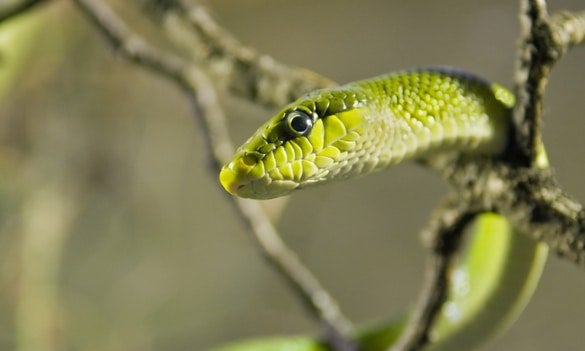
A snake bite presenting to general practitioners could be an emergency requiring immediate attention and ambulance conveyance to the nearest emergency department. Through a clinical case study, Changi General Hospital shares helpful resources and tips on how to manage such cases in the primary care setting – including checking for envenomation, wound care and immobilisation.
CASE STUDY
A 34-year-old male presented to the Changi General Hospital (CGH) emergency department (ED) with a snake bite in the anterior leg acquired while on a boat (Figure 1). He came to the hospital by his own transport within two hours.
Clinically, the patient had normal vital signs with no systemic and local signs to suggest envenomation. A picture taken of the snake using a mobile device was shared by the patient (Figure 2).
This was sent by instant messaging to ACRES (Animal Concerns Research and Education Society), which identified the snake as a non-venomous red-tailed racer (gonyosoma oxycephalum). The patient was discharged uneventfully from the ED after 13 hours of observation.
Figure 1 Snake bite

Figure 2 Red-tailed racer (gonyosoma oxycephalum)
RESOURCES FOR SNAKE IDENTIFICATION
In Singapore, we have found the following resources useful at helping to identify snakes:
- ACRES Wildlife Rescue Centre1
- Call 9783 7782 (operates 24/7)
- Call 9783 7782 (operates 24/7)
- National Parks Board / Animal & Veterinary Service2
- Email to the Singapore Zoo at infocounter.zoo@wrs.com.sg or through their online feedback form at www.avs.gov.sg/feedback
Call 1800 476 1600 and ask to have an expert sent to deal with the snake (operates 24/7)
In this case, the immediate assistance from ACRES via WhatsApp helped to reassure the patient and develop the management plan early. The availability of such resources should not delay the management of emergencies, or immediate transfer of patients by ambulance to the hospital.
Digital pictures should be taken from a safe distance and show the whole snake.
HOW TO MANAGE SNAKEBITE VICTIMS IN PRIMARY CARE
The following areas are important while attending to a snakebite victim:
|
1. General Points and Transportation | |
|---|---|
|
Resuscitation |
|
|
Reassurance |
|
|
Pain Control |
|
|
Tetanus toxoid |
|
|
Antibiotics |
|
|
Ambulance conveyance to the nearest ED |
|
|
2. Check for Envenomation | |
|---|---|
|
Systemic |
|
|
Local |
|
|
Note: Anti-snake venom (ASV) should be given only at the ED or where resources to manage anaphylaxis are immediately available.3 | |
|
3. Wound Care | |
|---|---|
|
Mark the leading edge of the skin swelling4 |
|
|
Cover the wound with a dressing |
|
|
Note: Do not attempt to cut the wound or suck the venom, as there is no proven benefit and this increases the possibility of infection. | |
|
4. Immobilisation | |
|---|---|
|
Immobilise the bitten limb |
|
|
Pressure immobilisation bandage |
|
|
5. Snake Identification | |
|---|---|
|
Do not handle the snake (if it is brought to the clinic) |
|
|
Digital picture of snake |
|
CONCLUSION
In conclusion, there are useful resources in Singapore to help identify and remove snakes. When in doubt, it is safer to assume envenomation after a snake bite and convey the victim to the ED without delay.
Marking the leading edge of skin swelling will help subsequent providers monitor progress of the condition, and good prehospital management will aid to improve outcomes.
REFERENCES
Animal Concerns Research and Education Society. ACRES Advisory Notice: Snakes [online]. Available at: https://acres.org.sg/core/wp-content/uploads/2017/01/ACRES-Advisory-on-Snakes.pdf. Accessed 27 Sep 2021.
National Parks. Snakes [online]. 5 Feb 2021. Available at: https://www.nparks.gov.sg/gardens-parks-and-nature/dos-and-donts/animal-advisories/snakes. Accessed 27 Sep 2021.
Weinstein S, Dart R, Staples A, White J. Envenomations: an overview of clinical toxinology for the primary care physician. American family physician 2009; 80:793-802.
Ashurst J, Cannon R. Approach and management of venomous snake bites: a guide for the primary care physician. Osteopathic Family Physician 2012; 4:155-159.
Zarisfi F, Pek JH, Oh JHH, Loke JH, Lim SH. Singapore First Aid Guidelines 2021. Singapore Med J. 2021; 62(8):427-432.
Parker-Cote J, Meggs WJ. First aid and pre-hospital management of venomous snakebites. Tropical medicine and infectious disease 2018; 3(2): 45.













 Get it on Google Play
Get it on Google Play